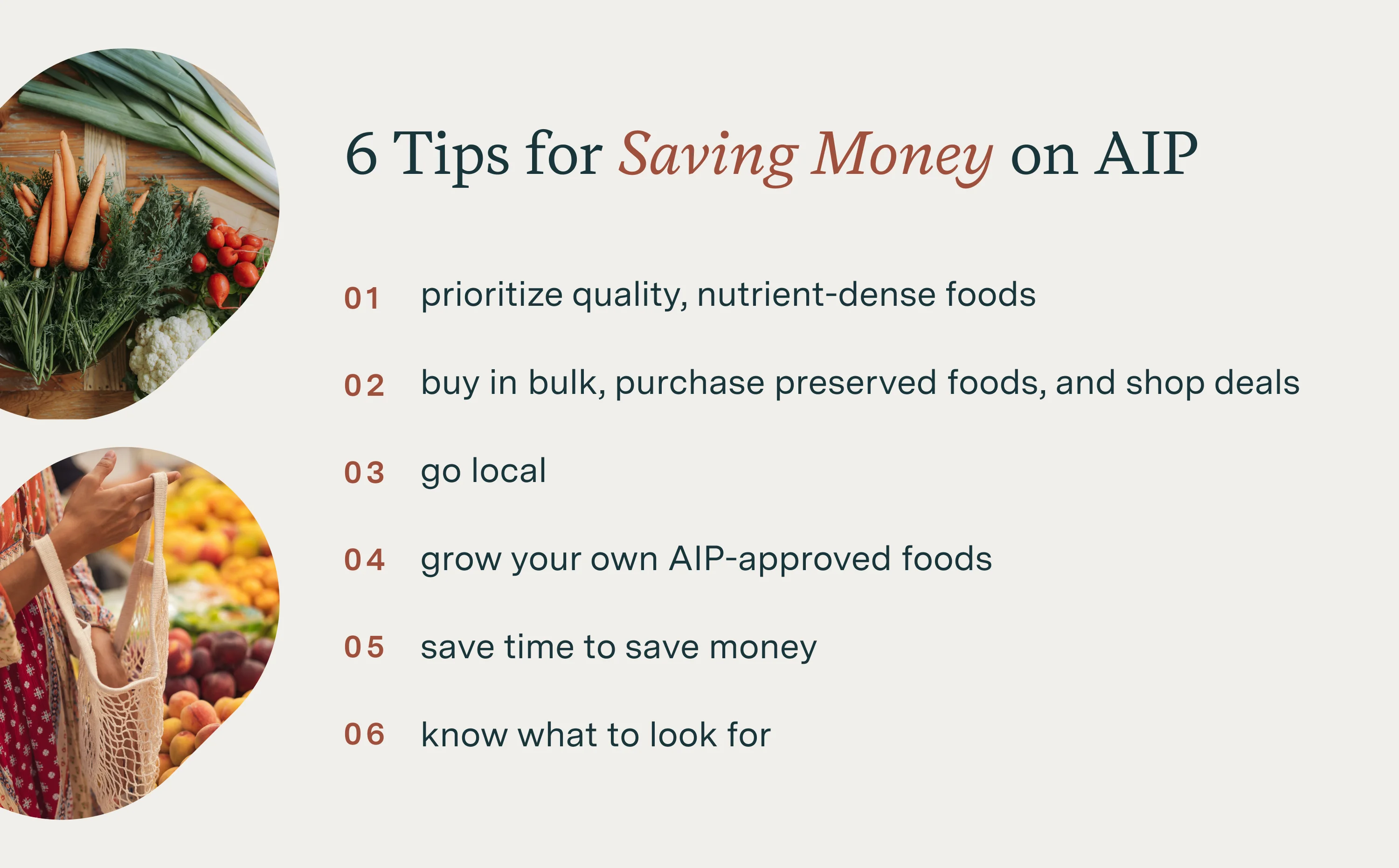The autoimmune protocol (AIP) has been shown to help many people with autoimmune conditions such as rheumatoid arthritis, Crohn's disease, ulcerative colitis, and Hashimoto’s thyroiditis. This diet is designed to decrease inflammation and support the immune system.
If you're already following AIP or planning to start, you might worry that it will be too expensive or wonder how you can save money while following the protocol. While AIP eliminates some commonly eaten foods, there are many ways to save money and still eat delicious AIP-approved meals. Read on for 6 simple ways to save money while on the autoimmune protocol — because living flare free should be accessible to everyone.

1. Prioritize Quality, Nutrient-dense Foods
AIP is an elimination diet aimed at removing specific foods that can contribute to inflammation and gut dysbiosis. The goal of the diet is to reduce autoimmune symptoms and improve overall health. Buying organic produce, eating with the seasons, and choosing healthier options are all staples of consuming quality, AIP-approved foods.
Opting to eat organic produce means choosing “cleaner” fruits and vegetables (those grown with fewer synthetic chemicals than used in conventional farming methods), as well as avoiding GMOs or potentially harmful ingredients such as high fructose corn syrup. Following the “Dirty Dozen” and “Clean Fifteen” lists from the Environmental Working Group can help you choose produce with lower levels of pesticide residue. (Source, Source)
It's a common misconception that organic means expensive, but if you know what to look for, organic foods can actually be similarly priced or less expensive than conventional products. Buying local and in-season produce can also ensure fresh, quality produce while keeping costs down.
Arguably most important is prioritizing food that is nutrient-dense and minimally processed. Some ways to do that include choosing grass fed meat over factory farmed meat, eating high protein foods, cooking with healthy AIP-approved fats such as avocado oil, olive oil, or coconut oil, and filling up on vegetables.
 3.jpg)
2. Buy in Bulk, Purchase Preserved Foods, and Shop Deals
One of the best ways to save money on your AIP diet is buying in bulk. Purchasing items that will last for a long time and don't go bad quickly makes it simple to save money. Additionally, wholesale stores are typically cheaper than traditional grocery stores. Be sure to ask your local groceries if they offer case discounts, as many stores will give at least 10% off the total cost if you buy a full carton of one product.
One concern with buying in bulk can be spoilage, while another limiting factor can be access to large, wholesale stores. Buying canned, frozen, or dried versions of ingredients — especially if you don’t have access to certain fresh fruits and vegetables in your area — can limit your worry about food going bad before you can eat it all. Preserved foods are typically available in regular grocery stores and can help keep costs down as they can be less expensive. These products can be just as nutritious and taste just as good, if not even better, than their fresh counterparts, because they're usually picked at peak ripeness.
At the market or wholesale store, you can find weekly deals on produce, meats, and seafood. One strategy for lowering grocery bills is to plan ahead. When something is cheap at one store but expensive at another, you can compare prices before making a purchase. If you have access to multiple stores, keep an eye out for sales in your area. You might be surprised to find that another store has a better price or larger selection.
Buy in Season
The cost effectiveness of stocking up on various food items can change throughout the year. Not everything is available all year long, so knowing what's seasonally available can help you maximize nutrients and freshness while keeping costs low. Fruits and vegetables that are in season will typically be cheaper, displayed in large quantities, and highlighted as fresh/seasonal. (Source, Source)
The seasonality of some other foods, such as meat and seafood, is a little less obvious. For example, seafood tends to be cheaper in the winter months than in the summer months. Summer is when they're more popular at restaurants, but many types of seafood (like Alaskan king crab) are caught in winter months. Meat also tends to be cheaper in fall and winter
Remember, though, that if certain food items are not in season or are out of stock, buying canned or frozen items can be just as good! Produce is picked and frozen when it is the most ripe, making it high in potential nutrients. Purchasing frozen produce instead of fresh produce when the prices are similar, especially if you're buying it in bulk (e.g., whole heads of cauliflower, broccoli florets), can give higher cost savings over time as well. Similarly, canned or frozen fish, seafood, and meat can also be less expensive when their fresh versions are out of season.
 2.jpg)
3. Go Local
Visit your local farmers’ market or go to a butcher — buying local is a great way to get the freshest whole foods you can find, while supporting and connecting with your community. Another plus: Local farmers and butchers will often have the best quality produce and meats at a lower price than supermarkets, making it an easy way to save money.
Save on Local Meats
Instead of packaged meats at the grocery store, butchers can often offer better deals because they buy directly from farmers and process their own meats. You can also ask a butcher about the meat's origin and how it is raised, ensuring high-quality proteins. To further save money at the butcher counter, buy whole roasts or cuts of meat that you can trim or cut down yourself. If you don't have a local butcher, consider purchasing a whole animal from a farmer and dividing it yourself before freezing portions for later use. While the upfront cost may be high, it can keep meat costs lower in the long run.
Shop Farmers’ Markets
Farmers’ markets are a great way to shop for local produce. Buying local food when possible is advantageous as it can be fresher and cheaper than foods grown farther from you. Produce that's shipped long distances tends to be more expensive than produce that’s grown locally, even when the local produce is organic. Additionally, local produce is usually harvested at the best stage, when it’s very ripe and highest in nutrients. This is because produce sold locally doesn’t need to be shelf stable for long periods of time — local produce is picked and sold much more quickly than non-local produce. (Source)
By shopping at a farmer's market, you can also ask for their seasonal produce list or ask the farmer directly, allowing you to get fresh, nutrient-dense produce. (You can also find what produce is in season at grocery stores if you don’t have access to a farmer’s market.) By shopping locally and in season, you can maximize nutrients while lowering costs overall.
Check out the Farmers Market Coalition website for a clickable map that makes it easy to find your nearest farmers’ markets.
A CSA Is Another Option
Even if you don’t live within a short distance from a farmer’s market, there are ways to get local, seasonal produce. Joining a community supported agriculture (CSA) farm share guarantees that you'll get fresh produce on a weekly or monthly basis at an affordable price. Many CSA organizations offer delivery or central pick-up locations so that getting your fruits and vegetables is as easy as going to the grocery store.

.svg)
.png)


%20.webp)

 5.jpg)
 4.jpg)





.webp)





.png)

 (1).webp)








 (1).jpeg)

.webp)
.webp)

.webp)

 (2).webp)

%201 (1).webp)

 2 (1).webp)




.svg)
.svg)